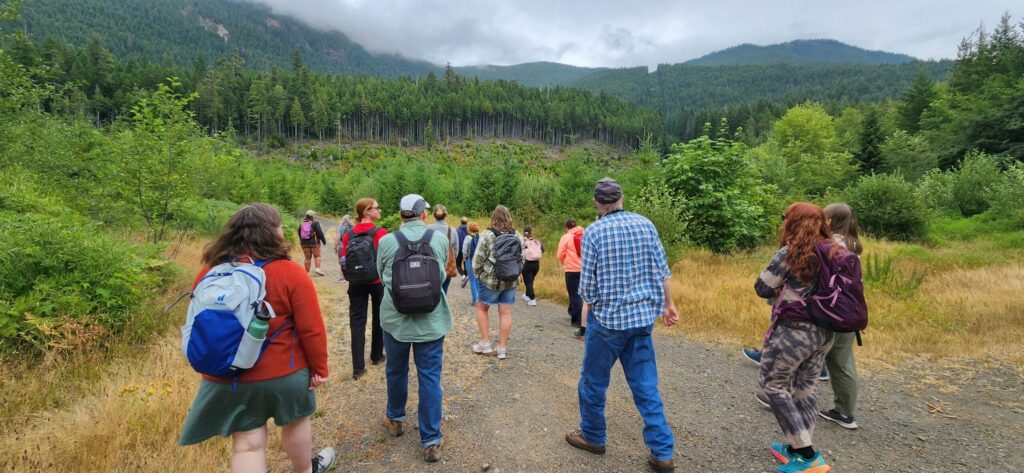Participants visited a Merrill & Ring forestry work site and learned about the many factors involved in forest management.
According to professor and science writer Richard Dawkins, “Science is the poetry of reality.”
This August, fifteen teachers at PEI’s Engaging Communities in Climate Education workshop turned that statement on its head by converting scientific data into various forms of poetry. Each teacher observed one tree at various times over three days, considering it through different lenses based on what they were learning about tree benefits, social and emotional connections, economics, how trees store carbon, and ways that climate change impacts forests.
Then came the assignment: take those observations and create a poem out of them. While it’s safe to assume no one attempted iambic pentameter, the teachers were up for the challenge and several read their efforts aloud. “All of the poems were so different,” says PEI’s East Sound FieldSTEM Coordinator Lydia Geschiere.
“The teachers got to see that making decisions [about forest management] is hard and it involves cooperation. That’s a valuable skill they can help their students to learn.”
— Lydia Geschiere, PEI’s East Sound FieldSTEM Coordinator
Geschiere and Molly Griffiths, PEI’s Associate Director, Puget Sound, and Executive Director Kathryn Kurtz facilitated the workshop at NatureBridge on Lake Crescent. The focus was the intersection of forest management, wildfire ecology, and climate change. Participants learned how varying forest management practices impact carbon storage, how carbon is sequestered and stored in trees, how carbon storage various among tree species, and how to use tools like iTree with their students to measure carbon and evaluate tree benefits.

On the first full morning, the group heard from a panel discussing different approaches to forest management as it relates to carbon sequestration, including representatives from The Nature Conservancy, Port Blakely, Washington Department of Natural Resources, and Merrill & Ring. “It was nice to hear the different perspectives from the panelists,” says Griffiths, “and to understand the magnitude of what goes into managing a forest. Even though they had similar management practices, there were still some differences in their management styles.”
Geschiere believes teachers took away an unexpected lesson from the panel: the critical role of collaboration among partners with diverse perspectives. “They got to see that making decisions is hard and it involves cooperation,” she says. “That’s a valuable skill that they can help their students to learn.”
Another highlight was a forest plot study about the value of trees on the program’s last morning. “They did a great job of discussing how to balance the economy of forests with other perspectives,” Geschiere notes. “We were in an old-growth forest and they were doing calculations underneath these huge trees to figure out what the value would be if they cut it down, but also thinking about the value of spending time in the forest and the processes that are happening around us because of the trees.”
In the final stages, the group planned how they would use the information and resources with students. Many expressed an interest in attending future workshops about forestry and climate science. If nothing else, it was a great way to celebrate the end of summer.
“I think coming to Nature Bridge was such a treat,” says Geschiere. “It was the gift of time and getting to be in a beautiful place and take advantage of the learning opportunities and downtime together.”
